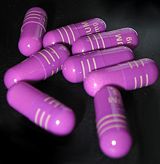Pharmaceutical Drugs
From Proteopedia
(Undo revision 3110545 by Alexander Berchansky (Talk)) |
|||
| Line 14: | Line 14: | ||
<td style="width:33%;border-width:1px; border-style:inset; text-align:center; background:#F1F2FC"> | <td style="width:33%;border-width:1px; border-style:inset; text-align:center; background:#F1F2FC"> | ||
==[[Alzheimer's Disease]]== | ==[[Alzheimer's Disease]]== | ||
| - | </td> | ||
| - | <td style="width:33%;border-width:1px; border-style:inset; text-align:center; background:#F1F2FC"> | ||
| - | ==[[Antifungal]]== | ||
</td> | </td> | ||
<td style="width:33%;border-width:1px; border-style:inset; text-align:center; background:#F1F2FC"> | <td style="width:33%;border-width:1px; border-style:inset; text-align:center; background:#F1F2FC"> | ||
| Line 28: | Line 25: | ||
<div style="overflow:auto; height:200px"> | <div style="overflow:auto; height:200px"> | ||
{{:Treatments:Alzheimer's Disease}} | {{:Treatments:Alzheimer's Disease}} | ||
| - | </td> | ||
| - | <tr> | ||
| - | <td style="width:33%; vertical-align:top;border-width:1px; border-style:inset"> | ||
| - | <div style="overflow:auto; height:200px"> | ||
| - | {{:Treatments:Antifungal}} | ||
</div> | </div> | ||
</td> | </td> | ||
Revision as of 14:20, 13 November 2019
The Pharmaceutical industry is one of the world’s largest industries, grossing well over $300 billion in the United States alone. Understanding how the drugs the pharma industry develops work and different characteristics of these compounds is important to nearly everyone as 50% of the US population takes at least one prescription medication regularly and nearly everyone takes a pharmaceutical pill at some point in their life.[1] The following is a growing list of pharmaceutical compounds organized by disorder.
See Pharmaceutical Drug Targets for a list of drug targets organized by disease.
The majority of all modern medicinal drugs target members of the superfamily of proteins called the G protein-coupled receptors or GPCRs[2][3].
Treatments
The following is a list of pharmaceutical treatments for various diseases, organized by disorder. Each entry highlights general information about the therapeutic, pharmacokinetic data comparisons within its drug class, and a structural analysis explaining how the drug compound functions in vivo.
Alzheimer's Disease |
Bacterial Infection |
Cancer |
|||
|
|
|
|||
Depression |
Diabetes |
Erectile Dysfunction |
|||
|
|
||||
Hypercholeseterolemia |
Hypertension |
HIV |
|||
|
|
|
|||
Inflammation & Arthritis |
Influenza |
Opioid drugs |
|||
|
|
|
References
- ↑ http://www.npr.org/blogs/health/2010/09/03/129626052/a-portrait-of-health-prescription-drugs-in-america
- ↑ Overington JP, Al-Lazikani B, Hopkins AL. How many drug targets are there? Nat Rev Drug Discov. 2006 Dec;5(12):993-6. PMID:17139284 doi:10.1038/nrd2199
- ↑ Peeters MC, van Westen GJ, Li Q, IJzerman AP. Importance of the extracellular loops in G protein-coupled receptors for ligand recognition and receptor activation. Trends Pharmacol Sci. 2011 Jan;32(1):35-42. PMID:21075459 doi:10.1016/j.tips.2010.10.001
Proteopedia Page Contributors and Editors (what is this?)
David Canner, Alexander Berchansky, Michal Harel, Karsten Theis, Wayne Decatur

